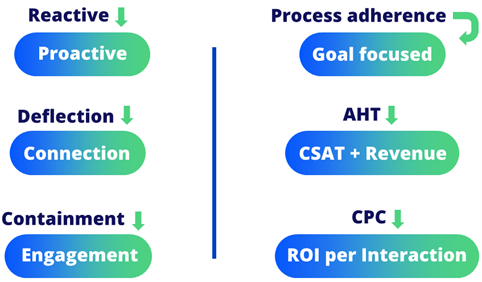By
Jarrod Davis
|
Date Published: October 29, 2024 - Last Updated October 29, 2024
|
Comments
Contact centers have struggled with many of the same issues for years now, and despite new software, hiring, adding channels and endless thought leadership — things don’t seem much better. It’s because they’re just helping us to tread water.
It’s time to realize we’re sinking because of the lead shoes we’re wearing: the legacy contact center.
Consumer technology sets the bar for what customers expect because every time they pull an iPhone out of their pocket, the experience seems like pure magic compared to most customer experiences. Rising expectations in terms of availability, quality and speed will not and cannot be solved manually. The increasing interaction volumes and rising level of complexity of issues is also not something we can hire or buy our way out of.
We need to explore an AI-first contact center. This new concept is not about adding AI, but recognizing that the challenges we face today are insurmountable with yesterday’s ideas.
An AI-first contact center places AI at the core of customer interactions — not because it’s the solution to everything, not because you should automate everything — but because it is the only way to scale and overcome today’s challenges with the resources you have.
AI-first means putting an AI platform that can orchestrate, automate and manage channels AI models and backend systems first, as your customer facing layer of technology. All interactions start there, even those you don’t automate. Core features include:
- Unified Interactions Across Channels: Instead of operating in silos (phone, chat or email), a single platform unifies and manages all interactions enabling short and long-term context and memory, as well as effortlessly moving between channels when the use case requires it (screen vs. no-screen; synchronous vs. asynchronous).
- AI Model Orchestration: The future contact center will harness multiple AI models — each designed for specific tasks like intent recognition, sentiment analysis or next-best-action suggestions. Some models will be more cost-effective in some situations, or perhaps better at reasoning than language generation. Perhaps some will generate multimedia, like on-demand videos for how to finish assembling a piece of furniture. Your AI platform will allow you to harness the full power and breadth AI to optimize outcomes based on use cases, latency requirements and cost considerations.
- Proactive and Predictive Service: Rather than only responding to customer inquiries, an AI-first setup anticipates potential issues and opportunities. AI can proactively notify customers of account anomalies, subscription renewals or suggest relevant products, transforming the experience from reactive to proactive.
- Agent Augmentation: AI won't replace human agents but will handle repetitive, low-complexity tasks, freeing up agents to focus on high-value interactions. This reduces the burden of monotonous work, allowing agents to engage in more meaningful, empathy-driven interactions — ultimately reducing agent burnout and attrition. AI agents assist human agents in real-time, with proactive suggestions and knowledge.
How AI-First Differs from Traditional Contact Centers
Historically, customer service models were human-centric, with an emphasis on phone interactions and efficiency — think call deflection and short handling times. In other words, get rid of those pesky customers as quickly as possible. However, that strategy no longer aligns with today's technological capabilities, customer expectations or competitive landscape.
When solutions like Cloud Contact Center as a Service (CCaaS) were introduced, they often felt revolutionary. But beneath the surface, they still focused on the same human-first strategies — just with a fresh coat of paint. AI-first contact centers don’t just break free from these limitations, but completely change what’s possible and what’s important.

4 Benefits of an AI-First Contact Center
The advantages of moving to an AI-first model begins with being able to handle today’s challenges with labor, rising expectations and interaction volumes.
- Enhanced Customer Experience: Customers experience smoother, more personalized interactions as AI ensures that every touchpoint follows a unified narrative, reducing the need for customers to repeat information.
- Unified interaction management: Because every interaction in every channel is touched by AI, no data, insights or customers slip through the cracks. Whether using self-service or talking to a human agent, AI is there like a guardian angel, ensuring everything is seen, heard, done and goes smoothly.
- Increased Efficiency and Cost Savings: AI automates routine tasks and manages high-volume inquiries, allowing human agents to focus on high-value tasks. This reduces operational costs and minimizes the workload on agents.
- Scalability: As interaction volumes grow, AI can handle increased demand without the limitations faced by human agents. This scalability ensures consistent service quality during peak times.